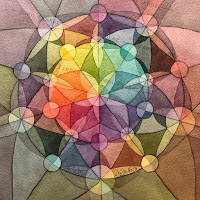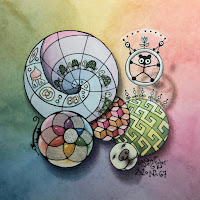New beading tutorial! Finally!
gwenbeads
Gwen Fisher's adventures in weaving beads, sewing, and making mathematical art
Saturday, April 22, 2023
Monday, April 25, 2022
Learn to Make Geometric Color Wheels with Watercolor Paint
My new watercolor tutorial on color wheels gives an advanced beginner’s lesson on how to paint artistic color wheels in a full rainbow of colors.

Learn
how to paint extraordinary color wheels using just 2, 3, 4 or 5
pigments. The tutorial include 4 projects, explained over 29 pages,
including 77 illustrations and full color photographs of 7 paintings
that are all explained in the text. This tutorial includes templates for
4 different projects for you to trace or copy.
Start with
detailed step-by-step instructions for a painting that uses just two
pigments. From there you will learn to mix three, four, and even five
pigments to create increasingly complex compositions. There is lengthy
discussion about choosing specific pigments for each of the four
projects so you can do the projects more than once and get different
effects depending upon the colors you start with. If you love colors,
you'll love this tutorial on painting color wheels and making the projects.
Tools &
Materials: watercolor paint, watercolor paper, palette with wells for
mixing colors, pencil, kneaded rubber eraser, brushes: round size 3 and 6
(or similar), cup(s) of water, water dropper, paper or cloth towel,
hair dryer, and a way to transfer the templates (discussed in the text).
Don’t just make swatch charts. Make art.
Wednesday, December 30, 2020
Color Wheels in Watercolor Paint
My favorite art to make lately has been painting color wheels with watercolor paint. This probably my favorite one so far. It is a color study of five pigments.
Sometimes I include color wheels into larger compositions.Sometimes I paint little color wheels to test out colors or an idea for future reference. I made this color wheel to test out a very red heavy color wheel. It uses both black and red ink.
I'm making myself a little book of color swatches, including a few color wheel, such as this one.
I used that one to help me paint this piece.
Some of my color wheels use a combination of traditional watercolor paint and mica paint, which looks metallic and flashes in the light. See the rainbow flash?
This color uses two reds, two yellows, and two blues, mixed in pairs.
Same with this one. Plus a cat.This color wheel also uses two yellows, two reds, and two blue, plus I used colored pencil on top to add the shading.
Wednesday, January 29, 2020
Seahorse Shirt Hand Stitched in Cotton Jersey
I had originally embroidered the seahorse to a front panel. No matter how I looked at it, the placement was unflattering. So the piece sat unfinished for eight months until I decided to move the embroidery to the sleeve. That’s why it has extra seams.
I designed the rest of the shirt to go with the seahorse. I wanted the seahorse to be the focus, the most detailed part, with the rest of the shirt simple, but not plain. After much thought and deliberation, I decided to add a trim to the rest of the t-shirt. Here you can seek all of the trim on the front, back, and second sleeve. A little appliqué like this is not only decorative, but also serves a purpose. It keeps the edge from rolling too much. I learned these sewing techniques from the books of Alabama Chanin.

Stitch, stitch, stitch...

Next I assembled the pieces. The finish on the neckline is my own invention. Learn to sew the neckline here: https://gwenbeads.blogspot.com/2019/12/t-shirt-with-stretchy-noodle-binding-on.html
Here’s the doodad.

Notice the parallel whip stitch where the sleeve connects to the bodice. I use whip stitch for the sewing and top stitching on that seam to make it stretchy. It’s a lot more comfortable for me when it’s stretchy there.
Monday, December 23, 2019
T-shirt with Stretchy Noodle Binding on Cotton Jersey
My sweetie like AV equipment and electronics. So I made this stencil just for him. I appliquéd the design with backstitch.
Here, I used my original binding technique with a jersey noodle. This is the second shirt I’ve made with this edge treatment, and I really like it.
I cut the strips of cotton jersey 1.25” wide before stretching them into noodles. Then I appliquéd the noodle to the edges in two passes as I show in the drawings here.































